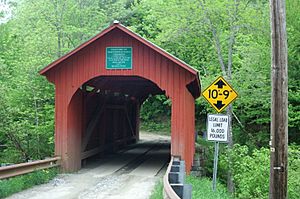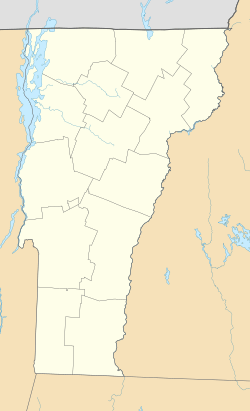Slaughter House Covered Bridge facts for kids
Quick facts for kids Slaughter House Covered Bridge |
|
|---|---|

Bridge in U.S. state of Vermont
|
|
| Carries | Automobile |
| Crosses | Dog River |
| Locale | Northfield, Vermont |
| Maintained by | Town of Northfield |
| ID number | VT-12-09 |
| Characteristics | |
| Design | Covered, Queen post |
| Material | Wood |
| Total length | 59.6 ft (18.17 m) |
| Width | 11.75 ft (3.58 m) |
| Number of spans | 1 |
| Load limit | 8 tons |
| Clearance above | 10.75 ft (3.28 m) |
| History | |
| Constructed by | unknown |
| Construction end | 1872 |
|
Slaughter House Covered Bridge
|
|
| Area | 1 acre (0.4 ha) |
| NRHP reference No. | 74000265 |
| Added to NRHP | June 13, 1974 |
The Slaughter House Covered Bridge is a cool old wooden bridge in Northfield, Vermont. It crosses the Dog River and is used by cars on Slaughterhouse Road. This bridge is special because it's a covered bridge, meaning it has a roof and walls like a house! It uses a design called a Queen post truss. This bridge was built a long time ago in the 1800s. It's one of five old covered bridges still standing in Northfield. Because it's so important, it was added to the National Register of Historic Places in 1974.
About the Bridge's Design
The Slaughter House Covered Bridge is found near the village of Northfield Falls. It's on Slaughterhouse Road, which used to lead to a business. The Dog River flows north here. It's a branch of the bigger Winooski River.
How It's Built
The bridge has one main section. It uses a special design called a Queen post truss. This means it has a strong frame made of wood. The bridge rests on stone supports called abutments. These supports were built using a method called dry laid stone. This means the stones were carefully stacked without using any mortar.
The main wooden frame of the bridge is about 59.5 feet (18.1 m) long. The entire bridge is about 14.5 feet (4.4 m) wide. It's just wide enough for one car to drive across at a time.
What It Looks Like
The outside of the bridge is covered with wooden boards. These boards are placed vertically, meaning they go straight up and down. The siding also covers the inside of the openings where cars drive through. These openings are called portals.
There's a small gap between the top of the siding and the roof. This open strip lets some light and air in. The ends of the roof that stick out are shaped in a special way. This shape is called a reverse ogee. It's a fancy curved design.
History of the Bridge
The Slaughter House Covered Bridge was built in 1872. That makes it over 150 years old! It's one of five covered bridges from the 1800s that are still standing in Northfield. This town has one of the highest numbers of these old bridges in Vermont.
The bridge has a weight limit of 8 tons. This means only vehicles weighing 8 tons or less can cross it. This limit suggests that the bridge's floor might have been made stronger. It probably got extra support from metal I-beams sometime in the 1900s. These are strong, I-shaped metal beams that help hold up the road.



